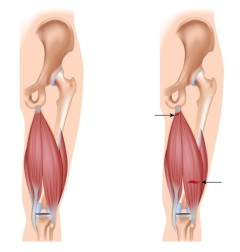
Hamstring Tendonitis/Strain
The hamstring muscles are situated at the back of the thigh, and they are strong bands of tissue that run along the length of the thigh bone, and are connected to the sitting bones at the base of the pelvis at the top end and just behind and below the knee at the lower end. The action of the hamstring muscle is to pull your lower leg behind you when you bend your knee. Subsequently they are used a lot in running activities.
Repetitive movement can lead to an overuse syndrome and subsequently tendonitis where the tendon inserts into the bone. With the hamstring this can happen at the top end by the sitting bone just below the buttocks, or at the lower end behind the knee.
Obviously with some sports there can be quick explosive bursts of speed required and also rapid changes of direction. This can place an unusual burden on the hamstring and lead to a muscle strain in the main belly of the muscle. Depending on the type of injury this is classified by grade.
- Grade One: a mild muscle pull or strain
- Grade Two: a partial muscle tear
- Grade Three: a complete muscle tear
With a complete tear, shockwave can be of little benefit, and surgery may be needed. However, with Grade One and Two injuries, shockwave can certainly accelerate the healing process.

